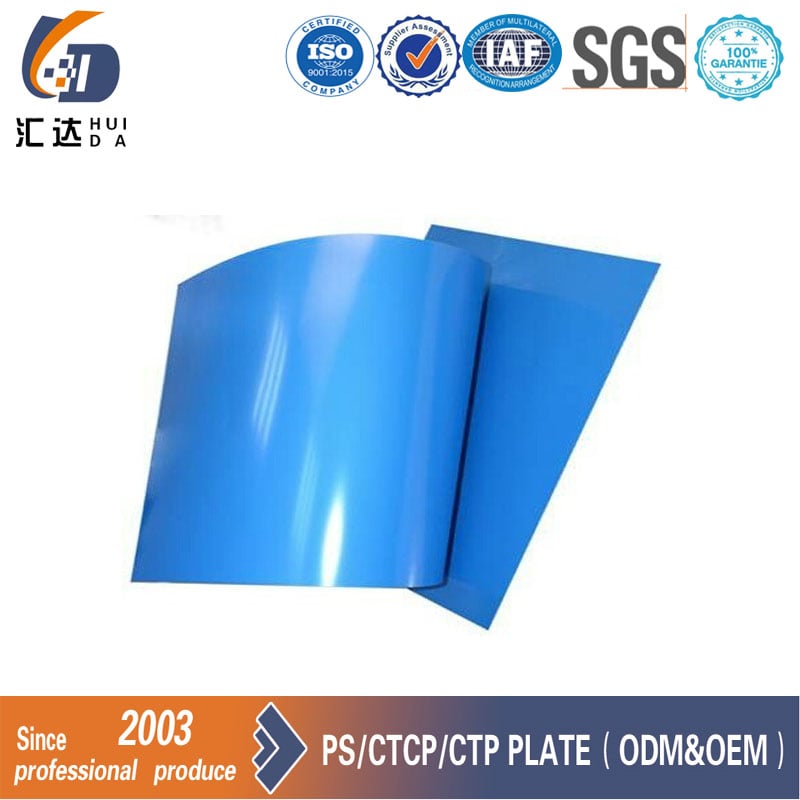
The imaging of the plate discussed in the previous article is undoubtedly very important to printing. But the plate is ultimately used for printing, and the printability of the plate is also a very important aspect. The most closely related factors in printing are water and ink. The ink affinity of the printing plate and the wetting performance of the printing plate directly affect the ink balance of printing and thus the quality of printing.
- Ink affinity
As we all know, offset printing is a process of forming imprints by controlling ink. The graphic part is ink-friendly, so it can accept the ink on the ink transfer roller, then transfer it to the blanket, and finally transfer it to the paper through the blanket. Obviously, the thickness of the ink on the printing plate directly affects the thickness of the ink on the blanket and paper. To control the density and color of printed matter, the thickness of the ink layer is a very important factor. The larger the range of controllable ink layer thickness, the greater the room for adjusting the printing quality during printing, which is more conducive to product quality control. Studies have shown that when a certain thickness of ink film is attached to the surface of the ink transfer roller, the amount of ink transfer on the printing plate depends on the ink affinity of the printing plate. If the ink affinity of the graphic and text parts of the printing plate is low, the range for controlling the amount of ink in the entire printing will be smaller, which will be detrimental to product quality. Moreover, if a printing plate with poor ink affinity is used, the remaining ink will accumulate on the ink transfer roller, thickening the ink film of the ink transfer roller, and excessive ink will accumulate at both ends, resulting in ink splashing and reducing ink covering. force. Therefore, CTP plates with good ink-receptive properties are very important.
In order to improve the ink-receptive performance of CTP plates, photosensitive materials with chemical properties that are close to the pigments, resins, and solvents in the ink should be used in the development of the plates. Testing the ink-receptive performance of the printing plate can be concluded by adjusting the ink volume of the ink transfer roller and conducting trial printing by measuring the density of each color block.
- Wetting performance
The wetting performance of the plate refers to the characteristic of selectively retaining water on non-image and text parts of the printing plate. The control of ink in printing depends not only on the amount of ink supply but also on the amount of water. Printing can only be done when the ink and ink balance is reached. Therefore, in printing, water and ink are a pair of contradictory entities that both struggle with and are unified with each other. If the amount of water in printing is too small, the parts without imprints will easily be stolen. If the amount of water in printing is too large, the imprints will be dull, uneven paper delivery, paper deformation, and inaccurate overprinting will occur.
When Germany's FOGRA tested fountain solutions in 1999, they also analyzed the wetting conditions of the plate. Analysis shows that because the surface of the CTP plate is extremely smooth, it has higher requirements for wetting. Its surface requires a thicker dampening liquid film than ordinary plates. The ideal thickness of the fountain solution film is 0.6-1.5μm. After this thickness is exceeded, the ink is over-emulsified and the resulting imprint has no luster. At the same time, the amount of water is too large. In order to achieve the balance of water and ink, the amount of ink required will also increase. At this time, the range of controllable ink amount will be reduced, which is not conducive to QC. Therefore, it is very important to adjust the hydrophilic properties of the printing plate to ensure that the thickness of the fountain solution film is between 0.6-1.5 μm when the water-ink balance is achieved.
It is obvious that the wetting performance of the printing plate is directly related to the grit of the printing plate. Traditional printing plates believe that the denser and deeper the grit, the better the wetting performance. However, for CTP plates, due to the fine grit, and the printing The surface of the blank part of the plate becomes smooth and difficult to wet. The resolution and dot stability of the printing plate and the wetting characteristics of the printing plate have become a pair of opposing contradictions under the special conditions of CTP plate manufacturing. The resolution and dot stability require a finer mesh, but the wetting conditions require that the mesh should not be too fine. Of course, the situation is not as bad as imagined, and in most cases, the two can be balanced. Some manufacturers (FUJI FILM) have also developed composite grit technology: coarse grit has water retention and is not easily get dirty; medium grit improves developability and print durability; fine grit maintains the balance between water and ink, and Improved wear resistance.
The hydrophilicity of the printing plate can be completed by adjusting the ink balance through actual printing tests. The wetting characteristics of the printing plate can be measured by testing the printing ink balance tolerance.
Huida Print-All Technology company is an advanced and professional manufacturer of producing printing plates, mainly sales CTP, CTCP, and PS plates as well as offering ODM/OEMs, especially for the offset. For more information, please click the official website link here: https://www.huidaoffsetplate.com/.

